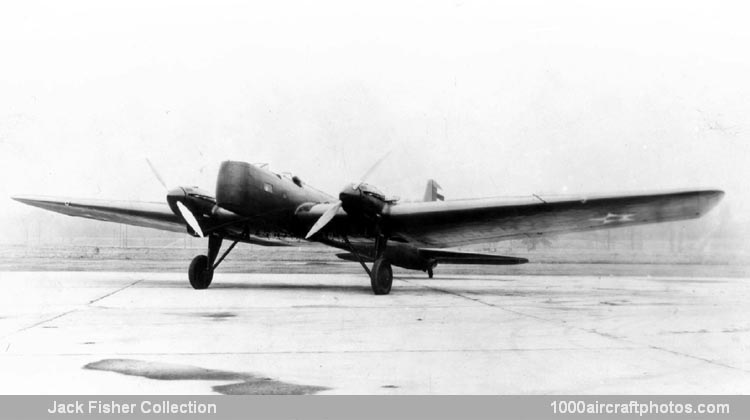01/31/2010. Remarks by Johan Visschedijk: "The models 214 and 215 were new bomber designs that applied the aerodynamic and structural concepts of the Model 200 Monomail to equivalent advances in another field traditionally dominated by the biplane. Both were developed at Boeing expense and differed only in engine installation. Model 215, powered with two Pratt & Whitney Hornet engines, was completed first. Like the Monomail, the new bomber introduced daring new structural and aerodynamic concepts while retaining traditional arrangements.
As in all bombers since WW I, the internal bomb bay was located in the fuselage at the center of gravity and additional bombs could be hung on external wing racks. The bombardier-nose gunner occupied a cockpit in the nose, which was equipped with a bomb sight and aiming window at the bottom and a mount for a flexible machine gun around the top. Because of the narrowness of the fuselage, the pilot and co-pilot occupied tandem cockpits immediately behind the bombardier instead of sitting side-by-side in a single wide cockpit.
A radio station was located ahead of and below them in the fuselage, and a fourth cockpit for a rear gunner was located on top of the fuselage behind the wing. In spite of the great advance in speed over contemporary bombers, all cockpits of the Models 214 and 215 were open. Because of the increased loads on the movable control surf aces at the higher speeds of the B-9, servo tabs were installed for the first time on an American aircraft to use aerodynamic forces to assist the pilots in moving the controls.
Model 214, originally powered with the 600 hp Curtiss GIV-1510C Prestone-cooled engine, was completed as a military aircraft because favorable testing of the first completed Model 215, resulted in the signing of an USAAC contract for the purchase of both aircraft on August 14, 1931, before the second one had flown. Model 215 was designated YB-9 (s/n 32-301) at the time of purchase and Model 214 was designated Y1B-9 (s/n 32-302).
The Y1B-9 made its first flight on November 5, 1931, and after testing with the liquid-cooled engines at Seattle and Wright Field, was converted to an air-cooled installation duplicating that of the 215/YB-9.
The Model 215 was completed and flown first, developed at company expense, it carried civil color and markings (NX10653) at the time of its first flight, April 13, 1931. It was tested by the USAAC as Boeing property under the experimental military test designation of XB-901; X for Experimental, B for Bomber, and 901 to designate the 901st test aircraft in a series that began at McCook Field in 1917 and was continued at Wright Field after the Army Test Center moved there in 1927.
The basic aircraft design was given the standard Army bomber designation of B-9, when purchased later in the year, and the prefix Y was added to indicate service test status. The aircraft was then repainted in military colors and the civil registration was cancelled.
While the B-9s are generally recognized as the aircraft that revolutionized bomber design, they were not the first monoplane bombers developed for the USAAC. They were preceded by the Douglas B-7 series and the General Aviation (Fokker) XB-8. While both of these designs featured retractable landing gears, their design concept was older than the B-9, both aerodynamically and structurally. Initial Army enthusiasm following the appearance of the XB-901 brought unofficial assurance of sizeable production orders, and Boeing believed that its pioneering efforts would be profitable.
However, the risks involved in pioneering in a highly competitive industry soon became apparent when the Glenn L. Martin Company brought out a private design of its own that was tested by the Army as the XB-907. It was a slightly later design than the XB-901 and had better performance, winning the large production orders under designation of B-10 and B-12 that Boeing had expected would be awarded to the B-9. Performance of the 215/YB-9 was essentially that of the 214/Y1B-9 and the dimensions were identical.
The Model 246/Y1B-9A was an improved version of Models 214/215 (Y1B-9/YB-9) ordered by the Army for service testing at the time the prototypes were purchased. Outwardly, it differed from the earlier models only in the shape of the vertical tail but incorporated many internal structural and equipment changes. The engines were 600 hp Pratt & Whitney Hornet Y1G1SR-1860B and high speed increased to 186 mph (299 kmh) with the altitude-rated engines. Military load was two 0.30 in (7.62 mm) machine guns and four 600 lb (272 kg) bombs.
The high speed of the new bomber had indicated the desirability of enclosing the cockpits for crew protection; while closed canopies called 'green-houses' were designed at the time they were not installed. The first of five Y1B-9As (s/n 32-303 to 32-307, c/n 1671 to 1675) flew on July 14, 1932, and was delivered to the Army on July 21. The last aircraft on the contract was delivered on March 20, 1933."
